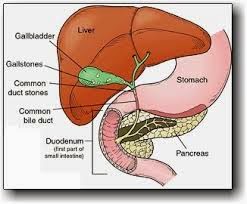How do you say VESICULA BILIAR in English?

When you 're really angry your Gallbladder looks much bigger (and greener)! The right term is GALL BLADDER or GALLBLADER. As you can see in the picture, the GALLBLADDER is a pear-shaped organ, right below the liver, whose only function is to store bile produced by the liver which later on will be released in the small intestine. It is the bile the substance that helps our body deal with the fat contained in digested food. Curiously. it is possible to live without a GALLBLADDER. If removed, the bile will simply go from the liver to the intestine. It is not advisable to do it though (since there is a reason for it to be there) unless it is so full of Gallstones that is more a problem than a solution. Gallstones are formed when the bile stored in the Gallbladder is so full of cholesterol that the bile solidifies thus provoking stones.





